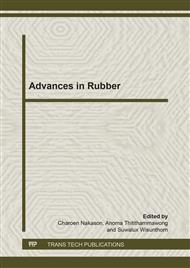p.127
p.131
p.135
p.140
p.144
p.149
p.154
p.158
p.162
Study of Rheological Behavior and Extrudate Surface Quality of Rubber Compounds
Abstract:
Protocol of capillary test for a characterization of rheological properties in various rubber compounds was implemented. By the use of capillary die specially designed by Michelin, the surface characteristics of the extrudate of various rubber compounds were investigated. Parameters investigated were: types of rubber matrix (NR, BR and SBR), loadings of carbon black and types of processing aids. The Index of Cohesion (IC), gained from the analysis of the extrudate surface severity, was used for predicting the cohesive force within the rubber molecules. The high IC value implied low magnitude of extrudate surface severity, i.e., high melt strength of the rubber compounds. Also, the investigation on extrudate surface appearance yielded the information on flow regimes, i.e., smooth surface, sharkskin instability and gross melt fracture. Furthermore, the extrudate surface quality was determined by the use of the rubber extruder equipped with the Garvey die as a standard tool for evaluating the extrudability of unvulcanized rubber compounds. The interconnection between IC value and Garvey die extrudability of rubber compounds was established. Result obtained revealed significant difference in extrudate surface characteristics of rubber compounds with different types and loadings of carbon black and processing aids. The SBR extrudates showed smooth extrudate surfaces whereas the BR extrudates exhibited sharkskin instability at any given output rate. Moreover, with increasing the black content, the SBR compounds showed the increment of the IC value meaning the reduction in magnitude of extrudate surface severity.
Info:
Periodical:
Pages:
144-148
Citation:
Online since:
November 2013
Authors:
Keywords:
Price:
Сopyright:
© 2014 Trans Tech Publications Ltd. All Rights Reserved
Share:
Citation:


